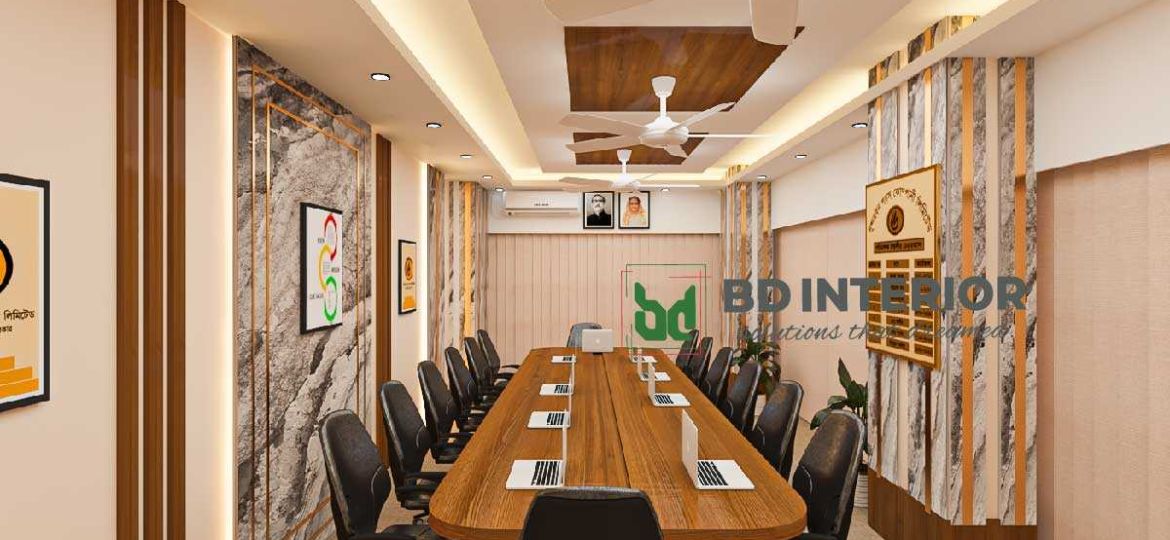
HOW INTERIOR DESIGN BOOST WORK PRODUCTIVITY IN A OFFICE
Designing an office interior with the goal of enhancing work productivity is a strategic undertaking that entails crafting a workspace conducive to focus, collaboration, comfort, and overall well-being. By meticulously orchestrating various elements within the office environment, businesses can cultivate an atmosphere that optimizes employee performance and satisfaction. This multifaceted approach involves thoughtful consideration of factors ranging from ergonomic furniture and aesthetic design to technology integration and employee well-being initiatives. In the subsequent exploration, we’ll delve deeper into these components, uncovering actionable insights and creative strategies to construct an office interior that becomes a catalyst for heightened productivity and a harmonious work experience.

Ergonomic Furniture:
Ergonomic furniture is designed to support the natural posture of the human body, promoting comfort and reducing the risk of musculoskeletal issues. Ergonomic chairs with adjustable features (height, armrests, and lumbar support) and sit-stand desks encourage proper posture and reduce strain. Invest in quality furniture that prioritizes employee health and well-being.
Natural Light and Lighting Design:
Natural light has numerous benefits for employees, including improved mood, reduced stress, and better sleep patterns. Arrange workstations to maximize access to windows and use blinds or curtains to control glare. For artificial lighting, consider using adjustable lighting fixtures to provide optimal brightness for different tasks.

Color Psychology:
Colors can impact mood and productivity. Cool colors like blue and green promote a sense of calm and focus, making them suitable for areas where concentration is essential. Warmer tones like yellow and orange can stimulate creativity and energy and are suitable for collaborative spaces.
Open and Private Spaces:
An open office layout encourages communication and teamwork but can also lead to distractions. Balance the open space with private areas like meeting rooms or quiet zones where employees can concentrate without interruption.

Plants and Biophilic Design:
Biophilic design integrates nature and natural elements into the workspace. Adding plants, living walls, or water features can enhance air quality, reduce stress, and improve overall well-being.
Noise Control:
Unwanted noise can disrupt focus and productivity. Employ sound-absorbing materials like acoustic panels or ceiling tiles to minimize noise levels and create a more comfortable working environment.
Organization and Storage:
A clutter-free workspace reduces distractions and improves mental clarity. Offer ample storage solutions such as cabinets, shelves, and drawers to keep documents and personal items organized.

Breakout Areas and Relaxation Spaces:
Encourage regular breaks by providing comfortable breakout areas and relaxation spaces. These spaces can be equipped with sofas, bean bags, or even games, allowing employees to recharge and return to work more energized.
Flexible Layout:
A flexible office layout allows for adaptability and versatility. Consider movable walls, modular furniture, and flexible seating arrangements to accommodate changing needs and team dynamics.
Technology Integration:
Seamless technology integration is vital for efficient collaboration and communication. Provide the necessary tools like video conferencing equipment, projectors, and charging stations to support employees in their daily tasks.
Art and Decor:
Artwork and decor that resonate with the company’s values can inspire and motivate employees. Consider displaying images that represent the company’s achievements, goals, or positive messages.

Wellness Initiatives:
Employee well-being is crucial for productivity. Offer wellness initiatives like standing desks to promote movement, meditation or quiet rooms for relaxation, and incentives for maintaining a healthy lifestyle.
Personalization:
Allow employees to personalize their workspaces with pictures, plants, or decorations. Feeling at home in their workspace can increase a sense of belonging and job satisfaction.
Feedback and Adaptation:
Regularly seek feedback from employees about the office design and take their suggestions into consideration. As the company evolves, the office design should also adapt to meet changing needs and preferences.
By integrating these elements thoughtfully, an office interior can create an environment that fosters productivity, collaboration, and employee satisfaction, ultimately leading to a more successful and efficient workplace.
0